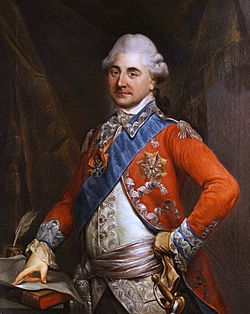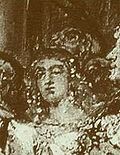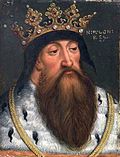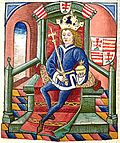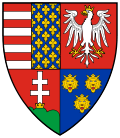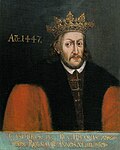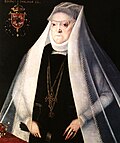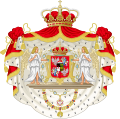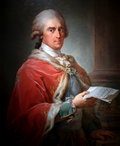Top Qs
Timeline
Chat
Perspective
List of Polish monarchs
From Wikipedia, the free encyclopedia
Remove ads
Poland was ruled at various times either by dukes and princes (10th to 14th centuries) or by kings (11th to 18th centuries). During the latter period, a tradition of free election of monarchs made it a uniquely electable position in Europe (16th to 18th centuries).
The first Polish ruler whose existence is not debatable was Duke Mieszko I, who adopted Christianity under the authority of Rome in the year 966. He was succeeded by his son, Bolesław I the Brave, who greatly expanded the boundaries of the Polish state and ruled as the first king in 1025. The following centuries gave rise to the mighty Piast dynasty, consisting of both kings such as Mieszko II Lambert, Przemysł II or Władysław I the Elbow-high and dukes like Bolesław III Wrymouth. The dynasty's rule over Poland ceased with the death of Casimir III the Great in 1370. In the same year, the Capetian House of Anjou became the ruling house with Louis I as king of both Poland and Hungary. His daughter, Jadwiga, later married Jogaila, the pagan Grand Duke of Lithuania, who in 1386 was baptized and crowned as Władysław II Jagiełło, thus creating the Jagiellonian dynasty and a personal union between Poland and Lithuania.
During the reign of Casimir IV Jagiellon and Sigismund I the Old, culture flourished and cities developed. This era of progress, also known as the Polish Renaissance, continued until the Union of Lublin under Sigismund II Augustus, which unofficially marked the end of the Polish Golden Age. After the death of the last Jagiellonian king, the united Polish–Lithuanian Commonwealth became an elective monarchy with mostly foreigners elected as monarchs such as Henry III of France, who witnessed the introduction of the Golden Liberty system and Stephen Báthory, a capable military commander who strengthened the nation. The meaningful rule of the Vasa dynasty initially expanded the Commonwealth as the arts and crafts developed, as well as trade and commerce. King Sigismund III Vasa, a talented but somewhat despotic ruler, involved the country in many wars, which subsequently resulted in the successful capture of Moscow and the loss of Livonia to Sweden. His son, Władysław IV Vasa, fiercely defended the Commonwealth's borders and continued the policy of his father until his death, unlike John II Casimir whose tragic rule resulted in his abdication.
The election of John III Sobieski to the Polish throne proved to be beneficial for the Commonwealth. A brilliant military tactician, John III led the coalition forces to victory at Vienna in 1683 and he partially recaptured land from the Ottoman Empire. However, the years that followed were not as successful.[3] The long and ineffective rule of the Wettin dynasty (Augustus II the Strong and Augustus III) placed the Commonwealth under the influence of Saxony and the Russian Empire. Additional feuds with rebel nobility (szlachta) and most notably Stanislaus I Leszczyński and France diminished the influence of Poland–Lithuania in the region, which led to the partitions that occurred under King Stanislaus II Augustus, yet another enlightened, but ineffective monarch. The last true sovereign of Poland was Frederick Augustus I as Duke of Warsaw, who throughout his political career attempted to rehabilitate the Polish state.
Following the Napoleonic Wars, many sovereigns claimed the title of Polish king, duke or ruler, notably German (the King of Prussia was also the sovereign of the Grand Duchy of Posen 1815-1918), Russian (the Congress Kingdom of Poland was founded in 1815 with the widely unrecognized title of King of Poland to the Emperor of Russia until 1915) and Austrian emperors (the Emperor of Austria was sovereign of the Kingdom of Galicia and Lodomeria between 1772 and 1918, and the Grand Duchy of Kraków between 1846 and 1918). The new Kingdom of Poland was proclaimed as an independent state in 1916 with a Regency Council but the monarchy was abolished and a parliamentary republican authority was established when Poland was re-constituted as a sovereign state in 1918.
Remove ads
Legendary
Summarize
Perspective
Most of the legendary Polish rulers appear for the first time in chronicles from the 13th century and their existence has not been determined.
Remove ads
Debatable rulers
The three direct predecessors of Mieszko I are known only from the account of Gallus Anonymus, who wrote the oldest Polish chronicle, Gesta principum Polonorum at the beginning of the 12th century. Though their historicity was once debatable, now historians tend to consider them actually existing rulers.[5]
Remove ads
House of Piast
Summarize
Perspective
Mieszko I started his reign as leader of Polans tribe, while other parts of future Poland were settled by other tribes, such as Masovians, Vistulans, Lendians, Silesians or Pomeranians. During his reign Mieszko united polish lands and adopted Christianity connecting Poland with western Europe. His descendents ruled the state as natural lords and Poland was seen as their hereditary property. Because of that, the state was often divided between sons of deceased ruler and eventually united by one of them. Early polish rulers were not considered equal to western European kings, so their title is translated as a duke. Some of them managed to prepare a coronation and adopted title of king, but effects of those efforts were short lived.
Fragmentation of Poland (1138–1320)
After period of fights between brothers and unstable inheritance Bolesław III Wrymouth decided to formalize succession. According to his testament the state was divided into provinces - one for every son and Senioral Province with capital city – Kraków. The testament established two principles on which new order in Poland was based - principate and seniorate. According to principate one duke - princeps (also called in English high duke) had supreme authority over other dukes and ruled in senioral province. According to seniorate princeps should be the oldest member of the dynasty, not necessarily son of the predecessor. During time of feudal fragmentation, as this period is called, both principles were abolished. Seniorate was formally abolished in 1180 during assembly of dukes and bishops in Łęczyca, where Casimir II the Just was made hereditary high duke. Principate was de facto abolished in 1227 with assassination of Leszek the White, after which local dukes no longer respected suzereinity of high duke, whose title became only prestigious.
Attempt at restoration (1295–1296)
In XIII c. the idea of reunification of Poland under single ruler started to gain popularity. It was often connected with coronation and establishment of hereditary kingdom. First attempts were made by Henry II the Pious and Henry Probus but both of them died before they manage to achieve their goals. First duke, who became king in this period was Przemysł II. He ruled briefly as high duke but didn't manage to unite polish lands. He crowned himself when ruling in his hereditary province - Greater Poland and in province of Eastern Pomerania. His assassination in 1296 prolonged unification of Poland by 20 years.
Remove ads
Přemyslid House
House of Přemyslid were natural lords of Bohemia and had many family connections with Piast dynasty. In 1291], Wenceslaus II of Bohemia exploited the weakness of internally divided Poland and conquered Kraków, basing his claim on loose family connection with one of the previous high dukes. He later legitimize his rule by marrying daughter of Przemysł II, which also gave him claims to Polish Kingdom.
Remove ads
House of Piast (restored)
Summarize
Perspective
Near the end of the reign of Wenceslaus II his rule over Poland was undermined by remaining polish dukes - especially by Ladislaus the Short, who was exiled by Wenceslauss and had strong claim to inheritance of Przemysł II, and by Henry III of Głogów, who also was successor of Przemysł. Assassination of Wenceslaus III of Bohemia, which led to extinction of Přemyslid dynasty and succession crisis in Bohemia, left Poland for Wenceslaus opponents. His successors in Bohemia called themselves kings of Poland until Congress of Visegrád in 1335. Eventually Ladislaus the Short managed to unite two main provinces of Poland - Greater Poland and Lesser Poland and crowned himself king in 1320 ending the period of feudal fragmentation.
Remove ads
House of Anjou
Summarize
Perspective
Casimir III the Great died without male heir. According to previous agreements his successor became his nephew, king of Hungary Louis I, beginning Polish-Hungarian personal union. After Louis death his kingdoms were separated - his younger daughter, Hedwig became king of Poland after brief interregnum (she is called king because in Poland title "queen" is reserved only for kings wife, not for sole ruler) and older daughter, Mary became queen of Hungary.
Remove ads
House of Jagiellon
Summarize
Perspective
Female king Hedwig started her reign young and unmarried, which gave Poland a huge opportunity. She eventually married the pagan Grand Duke of Lithuania Jogaila, who adopted the name Władysław after baptism. This event led to the creation of the Polish-Lithuanian personal union. After Hedwigs death, Władysław remained king of Poland, but he and his successors were no longer considered natural lords of Poland and often had to give privileges to nobility in exchange for support of succession of their children.
Remove ads
Polish–Lithuanian Commonwealth, 1569–1795
Summarize
Perspective
In 1569, king Sigismund II Augustus, knowing that he had no heir, united Poland and Lithuania into single entity - the Polish-Lithuanian Commonwealth, to ensure that after his death both nations will remain under the same monarch. He also declared that after his death, the nobility would elect his successor, beginning the elective monarchy not constricted to members of one dynasty, like during Jagiellons. He also ensured, that all nobles would decide the next king, not only the richest and most powerful ones. The first post-Jagiellonic elective king, Henry of Valois, signed the Henrician Articles, which guaranteed free elections and the rule of the nobility over the state. He, and every ruler after him, had to sign a 'pacta conventa' - a document of policies that the king promised to implement. After death of every king, an interregnum would be announced and the primate of Poland became an interrex; a temporary head of state, until a new king was elected.
Remove ads
Duchy of Warsaw, 1807–1815
After long period of instability and anarchy, the Polish-Lithuanian Commonwealth was divided among its neighbours - Russia, Prussia and Austria. During the Napoleonic Wars, Napoleon created the Duchy of Warsaw from the lands of the Prussian partition. Some parts of Austrian partition were later added to the Duchy. The Duchy had its own duke and government, but was fully dependent on France. After the fall of Napoleon, the duchy was divided between Russia and Prussia.
Poland from 1815 to 1918
After fall of the Duchy of Warsaw, the Polish lands were reorganised. Prussia annexed Greater Poland and created the Grand Duchy of Posen, Kraków became a free city and the rest of the former Duchy of Warsaw became part of the Russian Empire, as Congress Poland. In 1846, Kraków was annexed by Austria and in 1848, the Grand Duchy of Posen was dissolved. In 1867, after the failed January Uprising, the remaining autonomy of Congress Poland was abolished. During World War I, in German occupied Congress Poland, the Regency Kingdom was formed and lasted from 1917 to 1918. After Poland regained independence in 1918, a republican system with the president as head of state was established.
See the list of rulers of partitioned Poland.
Remove ads
Family tree of the rulers of Poland
This is a family tree of the Kings of Poland.
Remove ads
Pretenders to the Polish throne
- Vratislaus II of Bohemia (1085–1092)
- Rudolf I of Bohemia (1306–1307)
- Henry of Bohemia (1307–1310)
- John of Bohemia (1310–1335)
- Archduke Charles Stephen of Austria (1916–1918)
- Kiril, Prince of Preslav (1916–1918)[10]
Modern
- Alexander, Margrave of Meissen (2012–), disputed[citation needed]
- Rüdiger, Margrave of Meissen (2012–2022), disputed
- Daniel, Margrave of Meissen (2022–), disputed.[11] Son of Rüdiger
Not recognized royal elections
- Maxmilian II Habsburg (1575–1576), See: 1576 Free election
- Maxmilian III Habsburg (1587–1589), See: 1587 Free election
- François Louis de Bourbon (1697), See: 1697 Free election
See also
- Monarchism in Poland
- Coronations in Poland
- Dukes of Greater Poland
- Dukes of Masovia
- Dukes of Pomerania
- Dukes of Sieradz-Łęczyca
- Dukes of Silesia
- Kings of Poland family tree
- List of rulers of Partitioned Poland
- List of Galician rulers
- List of heads of state of Poland
- List of Poles
- List of Polish consorts
- List of prime ministers of Poland
- Princely Houses of Poland
- List of Lithuanian monarchs
Notes
- Throne of Poland was hereditary until 1399; Jadwiga was the last hereditary monarch, see Borkowska, Urszula (2012). Dynastia Jagiellonów w Polsce. PWN. ISBN 9788301205331. pp. 79, 481. "Jadwiga Anjou was considered the last 'naturally-enthroned Lady' of Kingdom of Poland. In Jagiellonian times in the politics of Corona Regni Poloniae persona of monarch became separated from country they were ruling. Throne became elective, although choice of the next ruler was restricted to the members of the [Jagiellonian] dynasty, until it had heirs." "Jadwiga (...) became a wife of Jagiełło, who was crowned the King (...), as co-ruler alongside Jadwiga, the last hereditary monarch of Poland."
References
Bibliography
External links
Wikiwand - on
Seamless Wikipedia browsing. On steroids.
Remove ads


